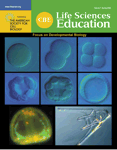Student Learning of Early Embryonic Development via the Utilization of Research Resources from the Nematode Caenorhabditis elegans
Abstract
This study was undertaken to gain insights into undergraduate students' understanding of early embryonic development, specifically, how well they comprehend the concepts of volume constancy, cell lineages, body plan axes, and temporal and spatial dimensionality in development. To study student learning, a curriculum was developed incorporating resources from the Caenorhabditis elegans research community. Students engaged in a preactivity assessment, followed by instructional materials (IMs) emphasizing inquiry-based learning and a postinstruction assessment to gauge their learning. This study, conducted at two research sites with eight and nine students, respectively, shows that before instruction, most students confused embryonic cell cleavage, where total volume is constant, with regular cell division, in which total cell volume doubles. Despite their ability to construct a cell lineage tree, most of the study participants were not aware of its biological significance. All students correctly identified cells of anterior and posterior axis, but not cells of the dorsal and ventral axis. Although the students had no difficulty with the time dimensional aspect of development, most viewed an embryo as spatially two-dimensional rather than three-dimensional. Furthermore, this study indicates that combining authentic research resources with inquiry-based learning benefits student learning of key concepts in embryology.



